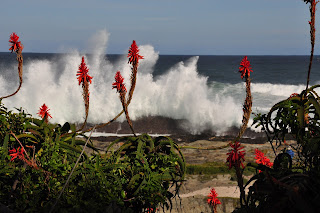Our first taste of the "bush" was in the Timbavati Game Reserve at Tanda Tula Lodge where we stayed in "tents." These were not the tents of my Camp Fire Girl days, nor the backpacking tents of my early twenties. In fact, these were hardly tents at all, except for the need to hook the zippers at the bottom of the openings to prevent pesky Vervet Monkeys from helping themselves to anything and everything inside. The tents had thick thatch roofs, a toilet area with stucco walls, an outdoor shower area within a stucco enclosure. The tent part included the walls of the sleeping area, which were on a wood floor shared with the porch.
I assumed the permanent walls were of a cement or stucco product. But Judith, a fellow traveler, emailed me after reading my blog. They were told that the walls were constructed of a mixture of mud and elephant dung. That makes perfect sense and so I have edited the blog with that tidbit of local construction information. Elephant dung is certainly plentiful.
During orientation, the staff were adamant that we not walk about alone at night, that we not go between the dining area and our tent without a ranger present. It is true that the area is unfenced (this camp did have a high, electric wire to keep elephants out, but that and giraffes are the only things it excluded). It seemed extreme and we could not help but wonder if the warnings were over rated, in part to make the experience seem "more real." Well, the next morning we found an impala, dead and partly eaten just outside the main reception area. Apparently hyenas had chased the impala into the compound. The impala was running when it hit the slick floors of the open sided reception area, and the hyenas brought it down. The scene that met us in the morning got our attention. We did not wander at night.
 |
| It was important to secure the zippers with a carabener. The local monkeys and baboons love to enter the tents and help themselves to whatever is there. |
 |
| The bath tub, toilet and sink are in a stucco adjunct behind the curtain. The shower is in a semi enclosed, open air "room" adjoining just beyond the bath tub area. Watch for monkeys while showering! |
Breakfast was served out of doors away from the camp. We would leave at dawn, watch and photograph for a couple of hour, stopping for coffee, tea, hot chocolate and biscuits after the first couple of sightings. Then, later in the morning we would go to this area for breakfast. The dish in the foreground is made with "mealies" the African term for corn, in this case, a corn meal type pancake.

We were out in the Land Rovers and Land Cruisers at both reserves, for sunrises and sunsets. Its the best time for wildlife. It is certainly the best time for photographers.
 |
| This image is mostly of the sunset reflection, but look closely. There are a couple of hippos, mostly submerged. |
Our second bush lodging was Inyati in the Sabi Sands Reserve. The accommodations were luxurious. This is a cabin for two. I could fit 5 motorhomes my size in the bedroom, parked tightly, but still in there. And the combined area of bath and dressing room is twice the size of my home on wheels. the mosquito netting is needed in summer. It was winter in the southern hemisphere and that is the dry time. Although we all came with anti-malaria meds, we saw no mosquitoes.

 |
| lunch was on the deck. |
Dinners are typically a braai, or BBQ affair. Both lodges had an open air dining area within a slightly walled exterior. The thatch roofed lounges or patios would be used in rainy weather. Here we are relaxing before dinner. The food? Fabulous and way too much of it: Kudu, springbock, impala, fish, all cooked on an open grill. Great side dishes, good company. Can't ask for more.
 |
| Another hippo |
 |

Except for the designated stops for eating or "bio breaks," visitors are required to stay in the
vehicles at all times. I am surprised someone is standing in the back of the cruiser with the leopard walking by. That was the other group from our lodge. Normally standing is strictly forbidden. The tiered seating provides good vision for all. Both the Land Cruisers and Land Rovers (different at each lodge) were remarkably comfortable. Used to my old Suzuki Sidekick, I expected driving on the dirt roads and just over the brush, would be jarring and miserable. It was not.
 |
| Cousin Sharon, front, and Bonnie, back, show up in the Land Cruiser's side view mirror. |




















































